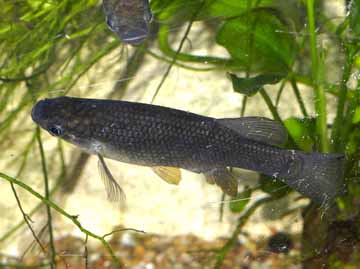Goodea atripinnis gracilis
Jordan, 1880
Dusk Fin Goodeid, Black Fin Goodeid
Synonyms: Goodea gracilis



Above: A Goodea atripinnis gracilis. Photo by Ted Judy.
Etymology:
Genus- Goodea= I believe it to mean bonus (Latin).
Species- atripinnis= black finned atri=black, pinnis= fin (Latin).
Subspecies- gracilis= slender (Latin).
Intro:
The Dusk Fin Livebearer is a vulnerable species of Goodeid from Mexico that is threatened by the introduction of invasive species. This peaceful fish is good for a community tank, and is very active.Distribution:
Like all Goodeid, the Black-Finned Goodeid is from Mexico. They are found throughout the Rio Punoco drainage.
Size, Maturity, and Sexual Dimorphism:
Size: Males- 3 inches, Females- 6 inchesMaturity: 2 inches
Sexual Dimorphism: Males are smaller than females and possess darker fins. Males also have a modified anal fin for reproduction called an andropodium. This can be seen as a notch in the anal fin.
Care:
Dusk Fin Livebearers are easy to care for. They are peaceful, so they can be kept in a community tank with no issues. They do prefer cooler water, but will be fine in a tank with a temperature of 74-76 degrees.
Diet:
These fish are omnivorous and will eat anything in captivity. They especially like live baby brine shrimp.
Breeding:
Black-Finned Goodeids breed like standard live bearers. This species has a very long gestation period, almost two months. The fry are huge when born, and number between 5 and 30. The fry hang at the top of the tank for their first week out of the womb. Fry are easy to raise on either baby brine shrimp, or crushed flake, and grow quickly.
Conclusion:
This is another great livebearer and is critically endangered, and needs our help. It may be difficult to find, but if you see them available, pick them up.
References:
- IUCN. IUCN Red List of Threatened Species. <http://www.iucnredlist.org>.
- Miller, R.R., Minckley, W.L. & Norris, S.M. (2005) Freshwater Fishes of México. Museum of Zoology, University of Michigan, & University of Chicago Press, Chicago, 652 pp.
